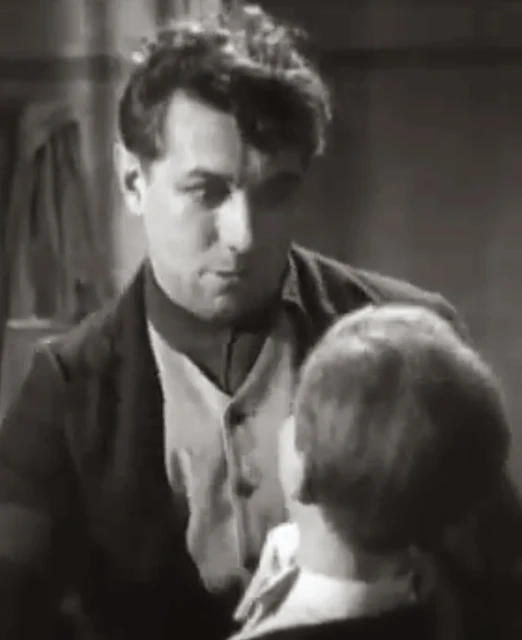(Warning: plot twists discussed in close detail)
Little wooden head
The Ealing Studio horror film Dead of Night (Alberto Cavalcanti, Charles Crichton, Basil Dearden, Robert Hamer, 1945) is like most portmanteau films an uneven affair, ranging from visually daring (man looking into mirror sees dark Gothic bedroom, Hamer) to awkward if charming (golfer haunts fellow golfer, Crichton), to psychologically harrowing (ventriloquist convinced his dummy is alive, Cavalcanti)--the whole bound up by a linking story (man at dinner party announces he's been through all this before, Dearden).
Hamer's "The Haunted Mirror" is shackled by a leaden script (you want to yell at the threatened couple "smash the mirror, morons!") which obviousness it manages to transcend--eventually--with the literal (and totally CGI-free) use of mirrors. Looking at them, into them, through them, watching people pause in dread before opening their eyes before them, Hamer's camera manages to convince us that the mirrors are less mirrors than windows into another world, where the possibilities are less marvelous than they are menacing.
The casually curious will want to check out the infamous Cavalcanti. Where "Hearse Driver" and "Christmas Party" and "Mirror" and the linking story depend on atmosphere and the occasional shock cut to scare us, what scares us in "The Ventriloquist's Dummy" is the spectacle of Michael Redgrave's Maxwell Frere slowly cracking up on the big screen. Well not really, and here's the difference: Redgrave doesn't play Frere as an insane man struggling to deal with the sane world; he plays Frere as a man in full (if precarious) possession of his sanity, doing his level best to deal with a world gone suddenly insane.
At first glance he's disturbed, wild-eyed, unpredictable; you flinch because his responses to people seem overwrought, inappropriate. It's when you realize (and it's a credit to Cavalcanti and Redgrave that they delay this realization as long as possible) that he's like this because he's reacting to everyone in the room plus one extra person (the dummy) that everything he does and says suddenly makes sense. That realization--that he's really not crazy after all--is the segment's true source of horror.
People have noted how much Hitchcock has borrowed from this for his masterpiece Psycho (the lone figure in a chair; the police officer walking into a cell with a bundle of cloth in his arms; the talk of a split personality being half of one and half of another, with one sometimes consistently dominant; the final image, of an unnatural voice coming from perfectly natural human lips); I can't think of anyone who's noted how much Anthony Perkins owes Redgrave. Norman Bates is an unsettling character not because he's insane but because he's sane, a perfectly rational character thrown into a (for him) totally irrational situation (his mother's still talking to him, even after death), and he's dealing with the matter the best he can. That's our entry point into Norman--and, fifteen years earlier, Maxwell's--mind: if we think that at some level of perception no matter how distorted or grotesque their actions might somehow make sense, then the distance between us and them is almost no distance at all.
How effective is Cavalcanti and Redgrave's gambit? At one point Maxwell starts strangling his mannequin and the observing doctor (Frederick Valk) rushes in to save the dummy. Maxwell's belief in his delusion is so intense he's managed to convince not just himself or those immediately around him but also a trained psychotherapist, and--be honest--in all that panic and confusion didn't you, however momentarily, feel the need to rescue the poor thing? Cavalcanti allows the camera to linger on the mannequin's crushed face, and one's revulsion can only come to fore: this? You wanted to run in and save this crumpled and pitiful block of wood?
After Cavalcanti's tour de force you'd think the rest of the film irrelevant and you'd be wrong: Dearden's been working in the sidelines on his eerily funny linking narrative, dropping clues here and there that despite the psychiatrist's reassurances things are getting worse, not better. He concludes everything with a delirious passage mixing all the segments together (that's what you need to finish an anthology film--a climactic sequence mixing all the stories up!) and most terrifying of all, a finale that echoes Joyce's Finnegan's Wake, where the realization dawns on you that what looks like the film's ending is actually its beginning--this daisy chain of horror has no real end.
Not a great film but with great segments, and of course Redgrave is unforgettable.
12.6.13

2 comments:
I found this film on late night Canadian TV. It scared me so badly!
I don't blame you
Post a Comment